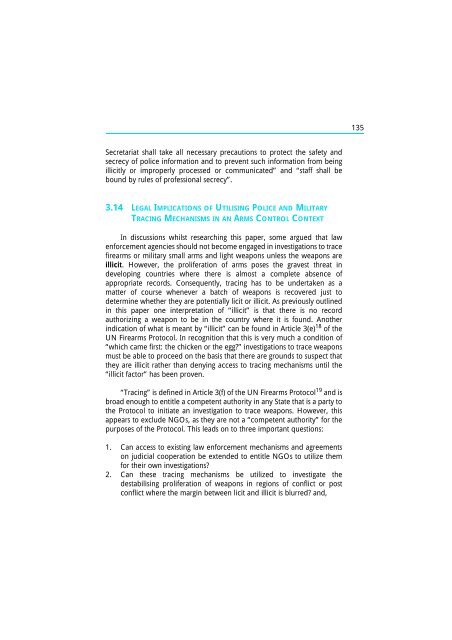The Scope and Implications of a Tracing Mechanism for Small Arms ...
The Scope and Implications of a Tracing Mechanism for Small Arms ...
The Scope and Implications of a Tracing Mechanism for Small Arms ...
You also want an ePaper? Increase the reach of your titles
YUMPU automatically turns print PDFs into web optimized ePapers that Google loves.
135<br />
Secretariat shall take all necessary precautions to protect the safety <strong>and</strong><br />
secrecy <strong>of</strong> police in<strong>for</strong>mation <strong>and</strong> to prevent such in<strong>for</strong>mation from being<br />
illicitly or improperly processed or communicated” <strong>and</strong> “staff shall be<br />
bound by rules <strong>of</strong> pr<strong>of</strong>essional secrecy”.<br />
3.14 LEGAL IMPLICATIONS OF UTILISING POLICE AND MILITARY<br />
TRACING MECHANISMS IN AN ARMS CONTROL CONTEXT<br />
In discussions whilst researching this paper, some argued that law<br />
en<strong>for</strong>cement agencies should not become engaged in investigations to trace<br />
firearms or military small arms <strong>and</strong> light weapons unless the weapons are<br />
illicit. However, the proliferation <strong>of</strong> arms poses the gravest threat in<br />
developing countries where there is almost a complete absence <strong>of</strong><br />
appropriate records. Consequently, tracing has to be undertaken as a<br />
matter <strong>of</strong> course whenever a batch <strong>of</strong> weapons is recovered just to<br />
determine whether they are potentially licit or illicit. As previously outlined<br />
in this paper one interpretation <strong>of</strong> “illicit” is that there is no record<br />
authorizing a weapon to be in the country where it is found. Another<br />
indication <strong>of</strong> what is meant by “illicit” can be found in Article 3(e) 18 <strong>of</strong> the<br />
UN Firearms Protocol. In recognition that this is very much a condition <strong>of</strong><br />
“which came first: the chicken or the egg?” investigations to trace weapons<br />
must be able to proceed on the basis that there are grounds to suspect that<br />
they are illicit rather than denying access to tracing mechanisms until the<br />
“illicit factor” has been proven.<br />
“<strong>Tracing</strong>” is defined in Article 3(f) <strong>of</strong> the UN Firearms Protocol 19 <strong>and</strong> is<br />
broad enough to entitle a competent authority in any State that is a party to<br />
the Protocol to initiate an investigation to trace weapons. However, this<br />
appears to exclude NGOs, as they are not a “competent authority” <strong>for</strong> the<br />
purposes <strong>of</strong> the Protocol. This leads on to three important questions:<br />
1. Can access to existing law en<strong>for</strong>cement mechanisms <strong>and</strong> agreements<br />
on judicial cooperation be extended to entitle NGOs to utilize them<br />
<strong>for</strong> their own investigations?<br />
2. Can these tracing mechanisms be utilized to investigate the<br />
destabilising proliferation <strong>of</strong> weapons in regions <strong>of</strong> conflict or post<br />
conflict where the margin between licit <strong>and</strong> illicit is blurred? <strong>and</strong>,
















